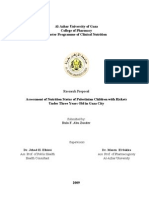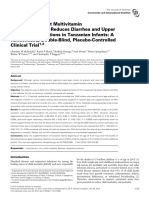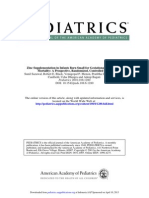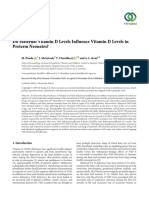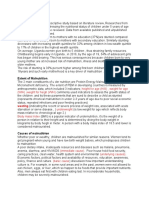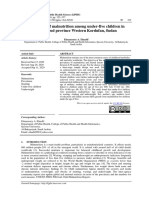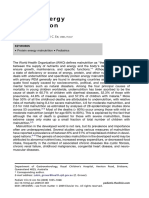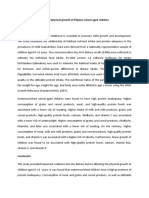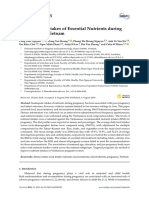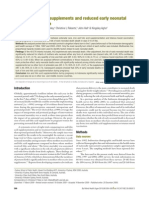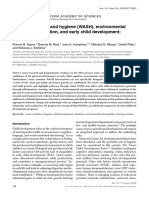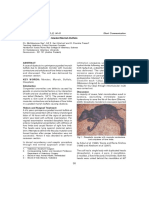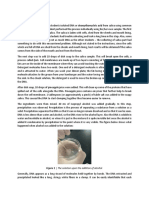Risk Factors For Nutritional Rickets in Children of Northern Kerala
Risk Factors For Nutritional Rickets in Children of Northern Kerala
Copyright:
Available Formats
Risk Factors For Nutritional Rickets in Children of Northern Kerala
Risk Factors For Nutritional Rickets in Children of Northern Kerala
Original Description:
Original Title
Copyright
Available Formats
Share this document
Did you find this document useful?
Is this content inappropriate?
Copyright:
Available Formats
Risk Factors For Nutritional Rickets in Children of Northern Kerala
Risk Factors For Nutritional Rickets in Children of Northern Kerala
Copyright:
Available Formats
IOSR Journal of Dental and Medical Sciences (IOSR-JDMS)
e-ISSN: 2279-0853, p-ISSN: 2279-0861.Volume 14, Issue 1 Ver. IV (Jan. 2015), PP 30-32
www.iosrjournals.org
Risk Factors for Nutritional Rickets in Children of Northern
Kerala
Soumya Jose1, Bindu A2, P M Kutty3
Department of Pediatrics,MES Medical College,Perinthalmanna
Abstract:
Objective: To assess the risk factors causing nutritional rickets among children in our part of world.
Subjects And Methods: 47 children with rickets and 47 control children matched for age and sex were
recruited over a 18 month period in a tertiary care hospital in northern kerala.Diagnosis was based on clinical,
radiological, biochemical parameters and response to treatment. Children who presented in our OPD with non
nutritional illness were used as control. A specially designed questionnaire was administered by one of the
investigators to both mothers of patients and control subjects to assess the role of social, nutritional and other
related factors in the pathogenesis of nutritional rickets.
Results:There was no significant difference between cases and controls for prematuriy,birth weight, birth
order, breast feeding and weaning practices.68% rickets patients did not have significant sun exposure but this
was not statistically significant( value 0.69).None of the children in study and control group received vitamin
D supplementation according to current guidelines. The study group had significantly higher percentage of first
degree relatives with rickets than controls (21% v/s 4%; value 0.01).
Conclusion: Nutritional rickets is multifactorial condition.We presume that most important predisposing
factor for nutritional rickets in our area is gestational vitamin D deficiency.
Keywords: Nutritional rickets,risk factors,vitamin D
I.
Introduction
Rickets is the term signifying failure in mineralization of growing bone or osteoid tissue. There are
many causes of rickets; among them nutritional vitamin D deficiency remains the most common cause
globally1.A severe vitamin D deficiency impairs mineralization of bone tissue (causing osteomalacia) and of
growth plates (manifesting as rickets)2.
Recent data indicates that vitamin D deficiency is pandemic, even the healthy and the young are not
spared3. High prevalence rates are reported in otherwise healthy infants, children and adolescents4, and also
from diverse countries around the world including India5.
Despite having adequate sunlight throughout the year, a substantial number of children suffer from this
preventable disease. Several factors, such as inadequate exposure of infants to sunlight, exclusive breast feeding,
darker skin2, poor housing, fully covered dressing style of mothers and multiparty have been implicated6.The
purpose of this study was to determine the role of different possible risk factors causing nutritional rickets
among the children in our part of world.
II.
Subjects And Methods
47 children with nutritional rickets and 47 control children matched for age and gender were included.
Diagnosis was made on clinical, radiological and biochemical parameters. Children responding to single
intramuscular injection of vitamin D(6lakhs IU) were diagnosed to have nutritional rickets. A specially designed
questionnaire was administered to both mother of patients and control subjects to assess the role of social,
nutritional and other related factors in the pathogenesis of nutritional rickets. Control group were children who
presented in our OPD with non nutritional illness.
The clinical criteria considered for the diagnosis of rickets were deformity of the lower limbs, wrist
widening and rickety rosary. Serum levels of following biochemical parameters were determined: hemoglobin,
serum calcium, serum phosphorous, alkaline phosphatase.Rickets was diagnosed by radiographic signs at the
wrist or knee. After getting informed consent details of the medical history, clinical and lab data were recorded
on specially designed forms. The medical history included gestational period, birth weight, birth order,
developmental aspects, illnesses and treatment received etc. Special emphasis was given to recording the
frequency and duration of exposure of the child to sunlight. The detailed nutritional history of the child included
the duration of breast feeding, weaning age and type of food given. Skin color was determined by the
pediatricians subjective assessment. We did thorough physical examination, including measurement of weight,
height and head circumference.
DOI: 10.9790/0853-14143032
www.iosrjournals.org
30 | Page
Risk factors for nutritional rickets in children of northern kerala
The statistical analysis of the study was conducted using SPSS 16.0.Chi-square was used to identify the
significance of the relations, associations and interactions among various variables. Odd ratios (OR) were
applied to explore the magnitude of the difference between cases and controls variables of our concern. The
result was accepted as statistically significant when the value was less than <0.05.
III.
Results
Data of 47 rickets patients and 47 control subjects were included for analysis. Table 1 shows
comparison of social, nutritional and general features between control and rickets group.
Table 1.Relation of various study variables in children with rickets and control
Parameter
Preterm
LBW
Birth order(>3)
Associated Disease
Weaning age(4-6/12)
Weaning food(ragi)
Long term medicine
Gross motor delay
Consanguinity
Family history
Sun exposure
Complexion (dark)
Normal HC
Severe (gd 3,4)stunting
PEM(gd 3,4)
Hb<11
Case(47)
5(10.6%)
10(21%)
8(17%)
7(14.9%)
35(74.4%)
28(59.5%)
5(10.6%)
13(27.7%)
3(6.3%)
10(21.3%)
15(31.9%)
2(4.2%)
38(80.9%)
8(17%)
3(6.3%)
17(36.2%)
Control(47)
7(14.8%)
17(36%)
11(23.4%)
44(93.6%)
31(65.95%)
24(51%)
5(10.6%)
4(8.5%)
2(4.2%)
2(4.3%)
19(40.4%)
0
42(89.4%)
0
0
29(61.7%)
OR(CI)
0.68(0.2-2.3)
0.47(0.1-1.1)
0.67(0.24-1.8)
0.01(0.0-0.04)
0.6(0.2-1.6)
0.7(0.3-1.6)
1(0.26-3.7)
4(1.2-13.7)
1.5(0.2-9.6)
6(1.2-29.5)
0.69(0.2-1.6)
2(1.6-2.5)
0.5(0.15-1.6)
0.45(0.36-0.57)
0.48(0.3-0.5)
0.39(0.15-0.81)
p value
0.37
0.08
0.3
0.00
0.25
0.26
0.63
0.015
0.5
0.014
0.69
0.24
0.19
0.003
0.12
0.01
21% patients had family history of rickets which was statistically significant (OR 6(1.2-29.5) and p
value 0.014).There was no significant difference between cases and controls for social and nutritional factors.
None of the children in both groups had received vitamin D supplementation according to current guidelines.
Significant gross motor delay was noted in rickets patients when compared to controls(OR 4.1 and p
value0.015) Comparing nutritional status of children in both groups, 17% rickets patients had severe stunting
which was statistically significant (p value 0.003).
IV.
Discussion
The etiopathognesis of rickets is thought to be multifactorial7.This study is an attempt to assess various
risk factors contributed to the disease.
The incidence of rickets was 32% in premature infant with birth weight below 1.5kg 8.Rickets in
preterm infants has decreased with improvement in care and nutrition 9 and our study supports this view.
The primary source of vitamin D for a newborn baby is the vitamin D that passes transplacentally to
the baby from the mother in the intrauterine period10. Currently, vitamin D intake during pregnancy and breastfeeding has been reported to be insufficient throughout the world. In a study done in Turkey maternal serum
25(OH)D3 concentrations were not significantly related to the number of pregnancies or births 11.Similarly in our
study no statistically significant difference was found in the incidence of rickets and birth order.
Concerning infant feeding practices no significant differences between rickets and nonrickets children
were found. While in many studies12,13,14 prolonged breast feeding and lack of good quality weaning food were
reported as risk factors.
The main source of vitamin D is cutaneous synthesis after exposure to ultraviolet B rays and several
studies support this view14,15,16.68% of our children in the study group were not getting sunlight exposure even
half an hour at least thrice a week. But this was not statistically significant. Thacher et al17 reported that
children with rickets had a greater proportion of first degree relatives with a history of rickets and our study
support this view.
Regarding association between nutritional rickets and different predisposing factors, it was observed
from our results that postnatal factors play not much significant role in the etiopathogenesis of rickets. The most
important predisposing factor is presumed to be gestational vitamin D deficiency. Unfortunately we didnt take
a detailed maternal history. While it was beyond the scope of this paper to measure vitamin D levels of both
mothers and children involved in both groups. It is still important to acknowledge that this may have played a
role in the high prevalence of nutritional rickets cases.
There is an urgent need for heightened awareness among health care providers and general public
about the importance of vitamin D.Attention to vitamin D status during pregnancy and lactation and
implementation of current recommendation in our area is warranted.
DOI: 10.9790/0853-14143032
www.iosrjournals.org
31 | Page
Risk factors for nutritional rickets in children of northern kerala
Acknowledgements
The author appreciate support and guidance provided by all staff in the department of pediatrics.
Contributors: All authors participated in conceptualizing the study. SJ: developed the analytical plan, analyzed
the data, searched literature and drafted and revised the manuscript. BA: interpreted the data and revised the
manuscript. PMK: edited and revised the manuscript. All authors approved the final manuscript.
Funding: There was no source of funding.
Competing interests: None
Reference
[1].
[2].
[3].
[4].
[5].
[6].
[7].
[8].
[9].
[10].
[11].
[12].
[13].
[14].
[15].
[16].
[17].
Curran JS, Barness LA. Nutrition. In: Behrman RE, Kleigman Rm, Jenson HB, editors. Nelson textbook of Paediatrics. Sixteenth
edition. Philadelphia. W. B. Saunders Company. 2000.p. 184-187.
Leanne M.Ward MD,Isabelle Gaboury MSc,et al.Vitamin D-deficiency rickets among children in Canada.CMAJ 2007;177(2):161-6
Narendra Rathi and Akanksha Rathi.Vitamin D and child health in the 21st century.Indian Pediatr.2011; 48:619-625.
Holick MF. The vitamin D deficiency pandemic and consequences for nonskeletal health : mechanisms of action. Mol Aspects
Med. 2008; 29:361-8.
Huh SY, Gordon CM. Vitamin D deficiency in children and adolescents: Epidemiology , impact and treatment. Rev Endocr Metab
Disord. 2008; 9:161-70.
Sedrani SH, Al-Arabik Abanmy A, Elidrissy A. Vitamin D status of Saudis: Seasonal variations. Are Saudi children at risk of
developing vitamin D deficiency rickets. Saudi Med.J. 1992;13: 4303.
Maged Mohamed Yassin and Abdel Monem H.Lubbad.Risk factors associated with nutritional rickets among children aged 2 to 36
months old in the Gaza strip:a case control study.International J of food,nutrition and public health.2010;3(1):33-45.
Rusk C. Rickets screening in the preterm infants. Neonate, Netw; 1998; 17(1):55-57.
Ghulam Rasool Bouk, Alam Ibrahim Siddiqui, Badaruddin Junejo et al.Clinical presentations of nutritional rickets in children
under two of age. Medical channel 2009;15(3): 55-58.
Ergur AT, Berberolu M, Atasay B, et al. Vitamin D deficiency in Turkish mothers and their neonates and in women of
reproductive age. J Clin Res Pediatr Endocrinol. 2009; 1: 266269.
Gke, Ayhan , Adem Yasin,et al.Incidence of maternal vitamin D deficiency in a region of Ankara,Turkey:a preliminary study.
Turk J Med Sci. 2014; 44: 616-623.
Fakhri Jamil Al-Dalla Ali.Prevalence of rickets and associated risk factors among children under 5 years of age attending the
outpatient clinic of maternity and children teaching hospital in Ramadi city.ISSN. 2011;9:2070-82.
Signe Sparre Beck-Nielsen, Tina Kold Jensen,Jeppe Gram et al.Nutritional rickets in Denmark: a retrospective review of childrens
medical records from 1985 to 2005.Eur J Pediatr.2009; 168:941949.
Molla M., Badawi M, Al-Yaish S, Sharma, P, et al.Risk factors for nutritional rickets among children in Kuwait. Pediatrics
International.2000; 42:280284.
Rehana Majeed,Yasmeen Memon,Mansoor Khowaja, et al. Contributing factors of rickets among children at Hyderabad.JLUMHS.
2007;60-65
Matsuo K, Mukai T, Suzuki S and Fujieda K. Prevalence and risk factors of vitamin D deficiency rickets in Hokkaido Japan.
Pediatrics International.2009; 51:559562.
Thacher TD.Case-Control study of factors associated with nutritional rickets in Nigerian children.J Pediatric.2000;137(3):367-73
DOI: 10.9790/0853-14143032
www.iosrjournals.org
32 | Page
You might also like
- LeanBodyChallenge ProgDocument11 pagesLeanBodyChallenge ProgMuzammil KhanNo ratings yet
- Manibabhula Nursing College, Bardoli: Subject: Medical Surgical Nursing Topic: Case Study OnDocument18 pagesManibabhula Nursing College, Bardoli: Subject: Medical Surgical Nursing Topic: Case Study Onmeghana100% (7)
- HydroceleDocument38 pagesHydroceleAlfie Yannur100% (2)
- Anorectal MalformationDocument28 pagesAnorectal MalformationJaya Prabha33% (3)
- Al-Azhar University of Gaza College of Pharmacy Master Programme of Clinical NutritionDocument10 pagesAl-Azhar University of Gaza College of Pharmacy Master Programme of Clinical Nutritionالمجلة العربية للعلوم و نشر الأبحاثNo ratings yet
- JN 212308Document8 pagesJN 212308Ivhajannatannisa KhalifatulkhusnulkhatimahNo ratings yet
- The First 1000 Days: A Critical Period of Nutritional Opportunity and VulnerabilityDocument3 pagesThe First 1000 Days: A Critical Period of Nutritional Opportunity and VulnerabilityEffika YuliaNo ratings yet
- HS390 Group6 ResearchDocument6 pagesHS390 Group6 Researchjoseyalm2323No ratings yet
- Retrospective Cohrt7-BestDocument21 pagesRetrospective Cohrt7-BestDegefa HelamoNo ratings yet
- Jurnal Zinc SupplementationDocument9 pagesJurnal Zinc SupplementationIndah Pratiwii IriandyNo ratings yet
- 2021 Article 1043Document3 pages2021 Article 1043Andrea GrandaNo ratings yet
- Factors Influencing Malnutrition Among Under Five Children at Kitwe Teaching Hospital, ZambiaDocument10 pagesFactors Influencing Malnutrition Among Under Five Children at Kitwe Teaching Hospital, ZambiaInternational Journal of Current Innovations in Advanced Research100% (1)
- Dietary Inadequacy Is Associated With Anemia and Suboptimal Growth Among Preschool-Aged Children in Yunnan Province, ChinaDocument9 pagesDietary Inadequacy Is Associated With Anemia and Suboptimal Growth Among Preschool-Aged Children in Yunnan Province, ChinaDani KusumaNo ratings yet
- EJCM - Volume 36 - Issue 1 - Pages 45-60-1Document16 pagesEJCM - Volume 36 - Issue 1 - Pages 45-60-1Yaumil FauziahNo ratings yet
- Artikel 2Document7 pagesArtikel 2Claudia BuheliNo ratings yet
- Research Article: Do Maternal Vitamin D Levels Influence Vitamin D Levels in Preterm Neonates?Document8 pagesResearch Article: Do Maternal Vitamin D Levels Influence Vitamin D Levels in Preterm Neonates?bellaNo ratings yet
- Research ReviewDocument4 pagesResearch ReviewLiikascypherNo ratings yet
- Risk Factor UrologyDocument5 pagesRisk Factor UrologyHamdan Yuwafi NaimNo ratings yet
- Congenital HypothyroidismDocument12 pagesCongenital HypothyroidismΌθωνας ΔεσποτίδηςNo ratings yet
- Pediatrics: DigestDocument9 pagesPediatrics: Digestdknight231No ratings yet
- Household Structure, Maternal Characteristics and Children's Stunting in Sub-Saharan Africa: Evidence From 35 CountriesDocument9 pagesHousehold Structure, Maternal Characteristics and Children's Stunting in Sub-Saharan Africa: Evidence From 35 Countriesmelody tuneNo ratings yet
- Manoj Proposal LastDocument5 pagesManoj Proposal LastsomadarahasNo ratings yet
- NIH Public Access: Author ManuscriptDocument17 pagesNIH Public Access: Author ManuscriptNila Indria UtamiNo ratings yet
- Prevalence of Malnutrition Among Under-Five Children in Al-Nohoud Province Western Kordufan, SudanDocument6 pagesPrevalence of Malnutrition Among Under-Five Children in Al-Nohoud Province Western Kordufan, SudanIJPHSNo ratings yet
- Protein Energy Maln Utr Ition: Zubin Grover,, Looi C. EeDocument14 pagesProtein Energy Maln Utr Ition: Zubin Grover,, Looi C. EeVivi HervianaNo ratings yet
- J Acap 2019 02 009Document26 pagesJ Acap 2019 02 009naya ernawatiNo ratings yet
- Naskah Publikasi-204Document8 pagesNaskah Publikasi-204Achmad YunusNo ratings yet
- Wright 2012Document14 pagesWright 2012kbejo.bnbNo ratings yet
- Improving Prenatal Nutrition in Developing CountriesDocument5 pagesImproving Prenatal Nutrition in Developing CountriesBenbelaNo ratings yet
- 10 11648 J SJPH 20130102 12Document6 pages10 11648 J SJPH 20130102 12SukmaNo ratings yet
- Maternal and Early-Life Nutrition and HealthDocument4 pagesMaternal and Early-Life Nutrition and HealthTiffani_Vanessa01No ratings yet
- Anthropometry Assessment in Children With Disease Related MalnutritionDocument10 pagesAnthropometry Assessment in Children With Disease Related Malnutritionberlian29031992No ratings yet
- 2020 InterpersonalcommunicationcampaignpromotingknowledgeattitudeintentionandconsumptionofironfolicacidtabletsandironrichfoodsamongpregnantIndonesianwomenDocument8 pages2020 InterpersonalcommunicationcampaignpromotingknowledgeattitudeintentionandconsumptionofironfolicacidtabletsandironrichfoodsamongpregnantIndonesianwomenAudriNo ratings yet
- Determinants of Mother's Preventive Practices Against Children's Acute Gastroenteritis: Basis For A Health Education ProgramDocument10 pagesDeterminants of Mother's Preventive Practices Against Children's Acute Gastroenteritis: Basis For A Health Education Programderma yahya wiharyoNo ratings yet
- StuntingDocument9 pagesStuntingAnonymous q8VmTTtmXQNo ratings yet
- Research Paper On Childhood Obesity in IndiaDocument7 pagesResearch Paper On Childhood Obesity in Indiafvg1rph4100% (1)
- Assessment of Knowledge of Antenatal Mothers Regarding Selected Health Problems of Complicated Pregnancy-A Cross Sectional StudyDocument7 pagesAssessment of Knowledge of Antenatal Mothers Regarding Selected Health Problems of Complicated Pregnancy-A Cross Sectional StudyAjay DNo ratings yet
- Final PaperDocument25 pagesFinal Paperapi-453846317No ratings yet
- Nutrients 08 00773Document22 pagesNutrients 08 00773Ibnu ZakiNo ratings yet
- Frequency and Determinants of Vitamin A Deficiency in Children Under 5 Years of Age With PneumoniaDocument6 pagesFrequency and Determinants of Vitamin A Deficiency in Children Under 5 Years of Age With Pneumoniayuni020670No ratings yet
- Dietary Patterns Exhibit Sex-Specific 3Document9 pagesDietary Patterns Exhibit Sex-Specific 3Luiz Eduardo RodriguezNo ratings yet
- Dietary KemmeDocument5 pagesDietary KemmeLeighvan PapasinNo ratings yet
- Nutrients: Low Dietary Intakes of Essential Nutrients During Pregnancy in VietnamDocument13 pagesNutrients: Low Dietary Intakes of Essential Nutrients During Pregnancy in VietnamV ZettaNo ratings yet
- Strategies of Reducing Malnutrition by Caregivers Amongst Children 0-5 Years in Opiro CommunityDocument8 pagesStrategies of Reducing Malnutrition by Caregivers Amongst Children 0-5 Years in Opiro CommunityEgbuna ChukwuebukaNo ratings yet
- A S F C S: Nimal Ourced Oods and Hild TuntingDocument18 pagesA S F C S: Nimal Ourced Oods and Hild Tuntingchandra dewiNo ratings yet
- Jurnal Tugas BacaDocument8 pagesJurnal Tugas BacaIstiana HairiahNo ratings yet
- Sir RoseloDocument6 pagesSir RoseloKate Leysa MamonNo ratings yet
- Maternal and Pediatric Nutrition JournalDocument6 pagesMaternal and Pediatric Nutrition JournalStacey CruzNo ratings yet
- Relationship Between Serum Vitamin D Level and Ectopic Pregnancy: A Case-Control StudyDocument6 pagesRelationship Between Serum Vitamin D Level and Ectopic Pregnancy: A Case-Control StudyMatias Alarcon ValdesNo ratings yet
- Nursaimah 2226010052Document11 pagesNursaimah 2226010052Deta helmiNo ratings yet
- Situational Analysis of Nutritional Status Among 1989 Children Presenting With Cleft Lip Palate in IndonesiaDocument13 pagesSituational Analysis of Nutritional Status Among 1989 Children Presenting With Cleft Lip Palate in Indonesiacvdk8dc8sbNo ratings yet
- Strategies For Reducing Malnutrition in Children From 0-59 MonthsDocument77 pagesStrategies For Reducing Malnutrition in Children From 0-59 Monthsjamessabraham2No ratings yet
- Iron and Folic Acid Supplements and Reduced Early Neonatal Deaths in IndonesiaDocument10 pagesIron and Folic Acid Supplements and Reduced Early Neonatal Deaths in Indonesiarobby zayendraNo ratings yet
- 2trik20191018 2trik TemplateDocument15 pages2trik20191018 2trik Templatedini afrianiNo ratings yet
- Impact of A Community Program For Child Malnutrition: Impacto de Un Programa Comunitario para La Malnutrición InfantilDocument11 pagesImpact of A Community Program For Child Malnutrition: Impacto de Un Programa Comunitario para La Malnutrición InfantilUmarul AkbarNo ratings yet
- Literature PHDocument4 pagesLiterature PHNoel KalagilaNo ratings yet
- Nutritional Status of School Age Children in Private Elementary Schools: Basis For A Proposed Meal Management PlanDocument5 pagesNutritional Status of School Age Children in Private Elementary Schools: Basis For A Proposed Meal Management PlanIjaems JournalNo ratings yet
- Midwifery 2022Document8 pagesMidwifery 2022Nasirullahi damilolaNo ratings yet
- Water, Sanitation, and Hygiene (WASH), Environmental Enteropathy, Nutrition, and Early Child Development: Making The LinksDocument11 pagesWater, Sanitation, and Hygiene (WASH), Environmental Enteropathy, Nutrition, and Early Child Development: Making The LinkspedrojakubiakNo ratings yet
- Mild Nutrion DR - SelviDocument3 pagesMild Nutrion DR - SelvigeraldNo ratings yet
- Lancet 2011 - Papers 1 and 2 PDFDocument31 pagesLancet 2011 - Papers 1 and 2 PDFpyeohhpyeNo ratings yet
- 259 Risk Factors For Severe Acute Malnutrition inDocument10 pages259 Risk Factors For Severe Acute Malnutrition inVibhor Kumar JainNo ratings yet
- Well-Child Care in Infancy: Promoting Readiness for LifeFrom EverandWell-Child Care in Infancy: Promoting Readiness for LifeNo ratings yet
- Effects of Formative Assessment On Mathematics Test Anxiety and Performance of Senior Secondary School Students in Jos, NigeriaDocument10 pagesEffects of Formative Assessment On Mathematics Test Anxiety and Performance of Senior Secondary School Students in Jos, NigeriaInternational Organization of Scientific Research (IOSR)100% (1)
- Necessary Evils of Private Tuition: A Case StudyDocument6 pagesNecessary Evils of Private Tuition: A Case StudyInternational Organization of Scientific Research (IOSR)No ratings yet
- Comparison of Explosive Strength Between Football and Volley Ball Players of Jamboni BlockDocument2 pagesComparison of Explosive Strength Between Football and Volley Ball Players of Jamboni BlockInternational Organization of Scientific Research (IOSR)No ratings yet
- Youth Entrepreneurship: Opportunities and Challenges in IndiaDocument5 pagesYouth Entrepreneurship: Opportunities and Challenges in IndiaInternational Organization of Scientific Research (IOSR)100% (1)
- Factors Affecting Success of Construction ProjectDocument10 pagesFactors Affecting Success of Construction ProjectInternational Organization of Scientific Research (IOSR)No ratings yet
- Fatigue Analysis of A Piston Ring by Using Finite Element AnalysisDocument4 pagesFatigue Analysis of A Piston Ring by Using Finite Element AnalysisInternational Organization of Scientific Research (IOSR)No ratings yet
- Design and Analysis of Ladder Frame Chassis Considering Support at Contact Region of Leaf Spring and Chassis FrameDocument9 pagesDesign and Analysis of Ladder Frame Chassis Considering Support at Contact Region of Leaf Spring and Chassis FrameInternational Organization of Scientific Research (IOSR)No ratings yet
- Design and Analysis of An Automotive Front Bumper Beam For Low-Speed ImpactDocument11 pagesDesign and Analysis of An Automotive Front Bumper Beam For Low-Speed ImpactInternational Organization of Scientific Research (IOSR)No ratings yet
- Chapter 16 Test Bank AnswersDocument13 pagesChapter 16 Test Bank AnswersLauraLaine100% (3)
- Common Dental ProblemsDocument14 pagesCommon Dental ProblemsInternational Journal of Innovative Science and Research TechnologyNo ratings yet
- Cast and TractionsDocument7 pagesCast and TractionsMerlene Sarmiento SalungaNo ratings yet
- Selectivebreedingpowerpoint 130416182435 Phpapp01Document18 pagesSelectivebreedingpowerpoint 130416182435 Phpapp01priarun18No ratings yet
- Geriatric Depression ScaleDocument3 pagesGeriatric Depression ScalevkNo ratings yet
- How To Lose Weight Through Calories DeficitDocument5 pagesHow To Lose Weight Through Calories DeficitRed RoseNo ratings yet
- Icsh Hemostasis Critical ValuesDocument12 pagesIcsh Hemostasis Critical Valuescitometria prolabNo ratings yet
- ABSTRACTDocument2 pagesABSTRACTAmpie MiguelNo ratings yet
- Surgical Face Masks in The Operating Theatre: Re-Examining The EvidenceDocument6 pagesSurgical Face Masks in The Operating Theatre: Re-Examining The EvidenceepNo ratings yet
- Jhia Teh's All You Need To Know HistoryDocument110 pagesJhia Teh's All You Need To Know HistoryJhia TehNo ratings yet
- Dicephalic Monster in A Graded Murrah BuffaloDocument2 pagesDicephalic Monster in A Graded Murrah BuffaloHari Krishna Nunna V VNo ratings yet
- Jerusalem ArtichokeDocument16 pagesJerusalem ArtichokeceramickurtNo ratings yet
- Harbin Oil Business Plan (Student ID 23991)Document13 pagesHarbin Oil Business Plan (Student ID 23991)HinaNo ratings yet
- RND Dna ExtractionDocument2 pagesRND Dna ExtractionJoshuaNo ratings yet
- HAEMORRHAGE Seminar-IDocument25 pagesHAEMORRHAGE Seminar-ISimran Josan100% (1)
- Mushroom DPR (54460)Document20 pagesMushroom DPR (54460)Pallav ChhawanNo ratings yet
- Kwak 2020Document4 pagesKwak 2020alyssaNo ratings yet
- Hook Surgery Practice Booklet PDFDocument4 pagesHook Surgery Practice Booklet PDFAnonymous b9RIEMekNo ratings yet
- Alchemy of FoodDocument4 pagesAlchemy of FoodprasujnairNo ratings yet
- Upper Gastrointestinal Bleeding Ugb Causes and Treatment 2475 3181 1000153Document3 pagesUpper Gastrointestinal Bleeding Ugb Causes and Treatment 2475 3181 1000153Envhy AmaliaNo ratings yet
- Theresian School of Cavite: Plectranthus AmboinicusDocument15 pagesTheresian School of Cavite: Plectranthus AmboinicusDINO NUGU AEGINo ratings yet
- Leffler 2017Document23 pagesLeffler 2017Dominic AmuzuNo ratings yet
- jhmbf01549 Sup 0001Document11 pagesjhmbf01549 Sup 0001RaghoodaNo ratings yet
- Hospital Acquired PneumoniaDocument21 pagesHospital Acquired PneumoniaNatashaDianasari100% (1)
- +lymphoedema 150118110815 Conversion Gate02Document24 pages+lymphoedema 150118110815 Conversion Gate02Oussama ANo ratings yet
- Nephrology Notes For USMLEDocument2 pagesNephrology Notes For USMLEGrilled Crowe100% (1)




